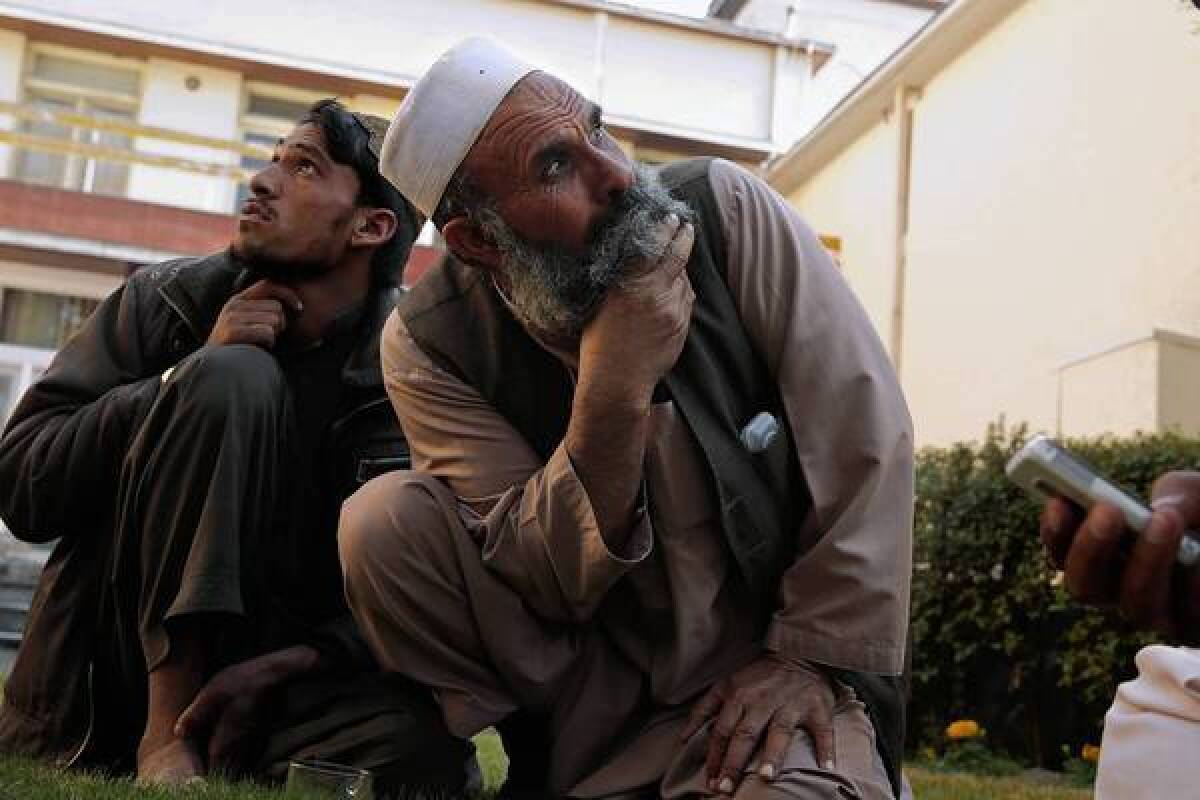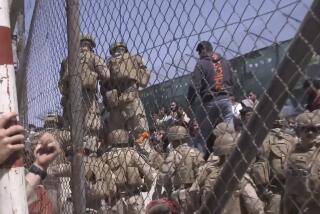Afghans describe relatives’ deaths in recent U.S. drone strike

JALALABAD, Afghanistan — Miya Jan was filling potholes on the rutted trail that leads to his village in rugged eastern Afghanistan when he heard the whine of a drone aircraft overhead.
The sunburned 28-year-old farmer looked up and saw a gray, narrow-winged drone circling the village. A few minutes later, he said, it fired a missile that landed with a tremendous thud across a stony ridge line.
Jan ran to the explosion site and recognized the burning frame of his cousin’s blue pickup truck. Inside, he said, he saw blackened shapes — people whose torsos had been sheared off. He recognized the smoking remains of his brother, his brother’s wife and their 18-month-old son. Jan and other villagers say 14 people were killed in the attack; U.S. and Afghan officials place the toll at 11.
“There were pieces of my family all over the road,” said Jan, recalling the deadly Sept. 7 late afternoon incident in an interview last week. “I picked up those pieces from the road and from the truck and wrapped them in a sheet to bury them.
“Do the American people want to spend their money this way, on drones that kill our women and children?” he asked.
The repercussions of such strikes are felt far beyond the dark escarpments of Kunar province. The grief and rage of Jan and his relatives help explain the approval among some Afghans of President Hamid Karzai’s thus far non-negotiable demand that civilian casualties cease if he is to sign a proposed 10-year security agreement with the United States.
Karzai responded to the Kunar attack by accusing the United States of recklessness and callous disregard for innocent Afghans. After a child died in a drone strike Thursday in southern Afghanistan, Karzai suggested that the attack had ended any chance of an accord.
Civilian deaths at the hands of U.S. forces have long poisoned Karzai’s relationship with the United States. That antagonism has hardened this month into a vise that could abruptly end America’s 12-year, multibillion-dollar investment in Afghanistan, despite a decline in civilian casualties due to new safeguards by foreign forces.
Civilian deaths in neighboring Pakistan for which the CIA’s covert drone program there has been blamed have elicited far more publicity than drone operations by the U.S. military in Afghanistan. Many Americans are not aware that dozens of armed drones fly over Afghanistan every day, part of the U.S.-led NATO coalition’s 300 to 350 daily aircraft sorties.
The missile that turned the pickup truck into an inferno is symbolic of the mistrust between Karzai and his erstwhile American patrons. As is often the case, the identities of the victims are shrouded in doubt in a nation where the difference between an insurgent and a civilian is measured in degrees.
In cases such as Thursday’s airstrike, both insurgents and civilians were said to be killed. The U.S. military typically responds by promising an investigation. Meanwhile, Karzai fans outrage with blistering denunciations of U.S. motives.
After the Sept. 7 attack in the village of Ganbir, the coalition initially said the airstrike killed “10 enemy forces” and emphasized that there were “no signs of civilians in the vicinity.”
On Saturday, Col. Jane Crichton, director of public affairs for NATO’s International Security Assistance Force, said a preliminary investigation had found that although the airstrike killed eight insurgents, “there were, unfortunately, believed to be three civilian casualties,” for which the ISAF expressed “deep regret.”
U.S. Air Force Maj. Gen. Ken Wilsbach, who commands air operations in Afghanistan, said, “Our goal is to eradicate civilian casualties, but that is an incredibly difficult task when the enemy is intermixed with the civilian population. We’re here to help the Afghan population, and there is absolutely zero intent to harm civilians.”
ISAF commanders often point out that the Taliban, according to the United Nations and other independent observers, are responsible for the vast majority of civilian deaths. Yet Karzai rarely condemns Taliban attacks that kill civilians, and certainly not as vociferously as when civilians are killed by coalition forces.
On Friday, the Karzai-appointed governor of Kunar told The Times that four women, four children and three civilian men were killed in the Sept. 7 strike. But Gov. Shuja ul Mulk Jalala also said he was told by the National Directorate of Security, Afghanistan’s CIA, that three of the victims were suspected Taliban fighters.
“Let me tell you, about 70% of the people in that area, especially in Ganbir village, are Taliban,” Jalala said. “The mullahs and the praying people are all Taliban.”
Four men from the village said in detailed interviews last week that everyone in the pickup was a civilian, all but four from their two extended families. They said the truck picked up four villagers as it returned from taking Jan’s sister-in-law to Kabul for medical treatment.
But the governor’s account suggests that if some of the truck’s occupants indeed were armed insurgents, the drone may have tracked them and targeted the pickup. U.S. Predator and Reaper drones often trail insurgents for hours or even days before an attack is ordered.
Jan and his relatives acknowledge that their village and district are Taliban strongholds. They say they are poor Pashtun farmers struggling to survive the daily grind of war, but now are inclined to support the Taliban. They did not mention civilians killed in Taliban attacks.
Abdul Ghafar, 19, who said he lost his mother, brother, sister-in-law and nephew in the drone attack, says he is hungry for vengeance. “If I could attack them, I would,” he said of U.S. forces.
The men seethed with resentment as they recounted details of the attack. Hazrat Gul, 38, who said he lost several relatives, demanded proof that the dead were armed insurgents.
“We have the ID cards of these civilians. We have their graves,” said Gul, who said he lent out his pickup that day. “If someone can prove these were Taliban, I would accept any punishment.”
The village men said the attack convinced them that Karzai was justified in rejecting the security accord. They want U.S. soldiers out of their lives forever.
“This agreement will only bring more misery,” said Gul, a stout, bearded man who wore a traditional wool pakol cap. “The Americans say they are here to protect us. No — they’re here to kill us and terrorize our women and children.”
As the men spoke, a drone passed slowly overhead, the dull whine of its turboprop engine audible over the din of traffic in the crowded city of Jalalabad, a three-hour drive from Ganbir.
“Look! You see it?” said Rahmat Gul, 55, Hazrat Gul’s cousin. He squinted up at the drone as it drifted across a brilliant blue sky.
“These be-pilots fly over our village almost every day,” he said, using a Pashto term that means a plane without a pilot. “They spy on people and steal their lives. Children are afraid to go to school. People are afraid to stand in a group because they fear these planes will shoot a missile at them.”
An hour later, a second drone buzzed overhead. The four men barely glanced up.
From his pocket, Jan, who sports a tangled black beard, produced a color photo of the only survivor of the attack, his 4-year-old niece, Haisha. It showed the girl’s disfigured face, her mouth and lower jaw blown away. Jan said the girl was horribly burned and blinded in both eyes, lost her left arm and needed reconstructive facial surgery.
Haisha was treated at ISAF hospitals at Kabul airport and at Bagram airfield, the men said. Col. Crichton confirmed that the coalition had provided medical transportation and care for Haisha.
Rahmat Gul said doctors at the Kabul hospital told him that Karzai wept at the sight of the girl’s ravaged face.
“If the president of our country cries and accuses the Americans and still nothing is done, what can we do?” Hazrat Gul asked. “We are poor people from the countryside. We have no power.”
Jan pulled out a creased copy of a Dari-language letter from Karzai to Marine Gen. Joseph F. Dunford Jr., commander of ISAF and U.S. forces in Afghanistan, in which Karzai pleaded for coalition medical assistance for Haisha.
On his cellphone, Hazrat Gul displayed photos he said were taken the day of the attack. One shows the blackened face of an infant wrapped in a white funeral shroud. This, he said, was 18-month-old Jandullah, Jan’s nephew.
Another photo depicted what Gul said was the scorched wreckage of his pickup. Others showed what appeared to be corpses wrapped in bloodied burial shrouds, and a wrapped body lowered into a grave.
The men complained, as has Karzai for years, of U.S. military night raids. Five years ago, Gul said, U.S. soldiers stormed his house at night. He said he, his two brothers and his father were handcuffed, detained and interrogated before being released.
After the Sept. 7 airstrike, the men said, angry villagers confronted Gov. Jalala in the provincial capital, Asadabad. They demanded an apology from the United States. The governor told them it was “an American affair” and he could do nothing, the men said.
The villagers said the families had received no compensation from the coalition. Crichton said that a condolence payment was made to one family but that the ISAF had not identified other families who may have suffered losses.
“We don’t want compensation,” Jan said. “We want the Americans to find the person who reported Taliban and terrorists in that truck, and we want him prosecuted and punished for his lies.”
The men scoffed at U.S. insistence that the rights of Afghan women be improved. “Is it women’s rights when they kill women and mix their body parts with men’s?” Jan asked.
With drones flying over their villages, the men said, they sleep the uneasy sleep of the fearful. Another strike or raid could come at any time.
The villagers say they cling to their best evidence that the United States kills and maims Afghan civilians — the lone survivor, Haisha.
“God’s gift,” said white-bearded Rahmat Gul, glancing up at the sky. “God left her alive as proof.”
Special correspondent Hashmat Baktash in Kabul contributed to this report.
More to Read
Start your day right
Sign up for Essential California for news, features and recommendations from the L.A. Times and beyond in your inbox six days a week.
You may occasionally receive promotional content from the Los Angeles Times.







